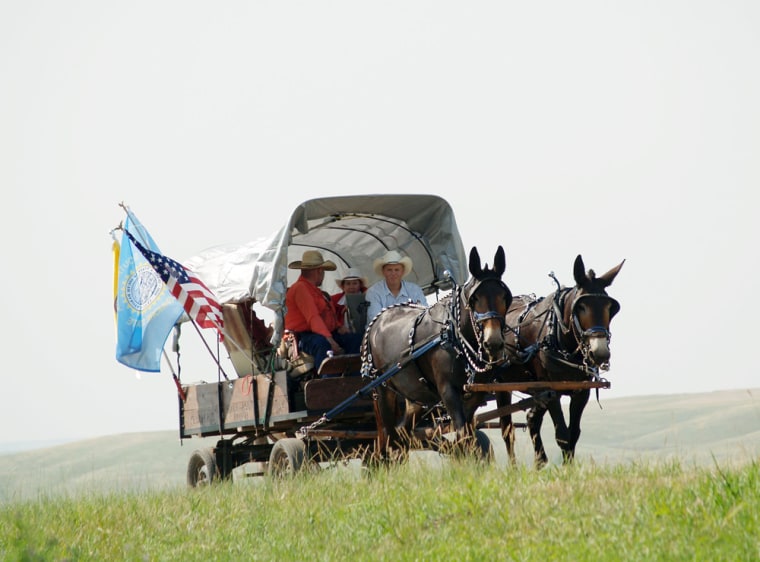Creeping up a steep bluff along the Missouri River, two sure-footed mules pulled an old wooden wagon fitted with rubber tires, bucket seats and seatbelts.
The modified prairie schooner leads a wagon train that embarked Wednesday on a 240-mile trek across the rugged plains to historic Deadwood.
The 17-day trip marks the 100th anniversary of the last wagon train to travel the route to the Black Hills. After gold was discovered in 1874, one of the shortest and easiest paths for people and freight headed for Deadwood was overland from Fort Pierre.
Fifty-four wagons, pulled by horses, mules and oxen, began the anniversary ride. They were accompanied by 225 people on horseback.
Getting in shape
Some will stick out the whole trip. Others may ride only a day or two.
"I think we'll lose 10 percent the first two days," said wagon master Gerald Kessler, who has gone on 78 wagon train excursions since 1990.
"People just ain't got themselves in shape and their horses in shape," he said. "And we've got a lot of older people that probably haven't ridden 20 miles in 20 years."
The prairie is dotted with cactus, sagebrush and yucca. Some places still bear deep scars from the wagon wheels that rolled over the route for a third of a century.
Kessler, who raises mules on a ranch 17 miles northwest of here, expects to encounter mishaps similar to those who traveled the route before railroads made the wagon trains obsolete.
"You're going to have your day-to-day wrecks, breakdowns and buck-offs," he predicted.
The lure of the open range and the history of the route drew John Aune to ride the trail.
"It will bring back some of the old days," said Aune, a 68-year-old retired dairy farmer from Hendricks, Minn.
Not an easy trip
He acknowledges riding his horse won't be easy at his age.
"I'll have more trouble than my horse, probably," he said while waiting for the caravan to depart.
The wagon train will face searing summer heat, miles of uncertain footing, dicey stream crossings and rattlesnakes — although Kessler said he's only killed one rattler on his ranch this year. Usually, he's killed about 10 by now.
Kessler alerted his fellow travelers to the dangers ahead and spelled out the rules of road.
"The most important rule is, don't hurt the wagon master," he quipped, tipping the brim of his big straw hat.
Rain can make the prairie treacherous, and that might force some route changes, he said. But for the most part, within 100 yards or so, the wagon train will follow the original trail all the way to Deadwood, he said.
Slight detours will be made to bypass wide swaths of wheat to be harvested this summer, Kessler said.
It's remarkable that all landowners along the trail agreed to let the wagon train pass through their property, Kessler said. Many of them also planned to tag along, although they are not counted in the 300 or so signed up for the trip, he said.
The historic trail was closed in 1908 when rail lines began moving people and cargo from Fort Pierre to the Black Hills. By then, the gold in the Black Hills was depleted and much of the land had been taken over by farmers and ranchers.
